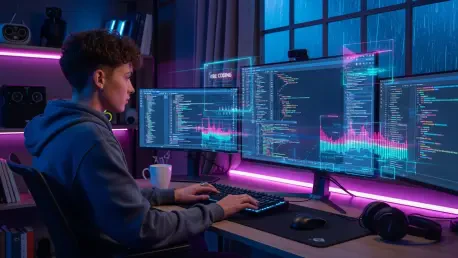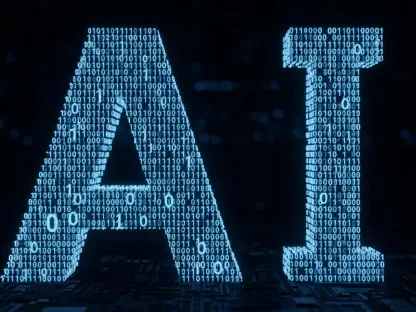In the rapidly evolving landscape of technology, a striking development has captured the attention of industry insiders: the rise of AI-driven coding practices that allow users to generate code through simple natural language prompts. This phenomenon, often referred to as AI vibe coding, promises to democratize programming by enabling non-technical individuals to create software with minimal expertise. Yet, beneath this accessibility lies a pressing concern—could this reliance on AI tools be eroding the very foundation of innovation and control in software development? As tech companies and individual creators increasingly adopt these solutions, the balance between efficiency and originality hangs in a delicate state, prompting a deeper examination of their impact on the industry.
Understanding AI Vibe Coding and Its Industry Impact
AI vibe coding represents a transformative approach where users describe desired outcomes in plain English, and AI tools like Cursor or Lovable translate these prompts into functional code. This method eliminates traditional barriers, allowing people without formal programming knowledge to participate in software creation. The simplicity of this process has sparked widespread interest across various sectors, from startups to established enterprises, eager to leverage AI for rapid prototyping and development.
The tech industry today stands at a crossroads, with AI integration becoming a cornerstone of coding practices. This shift has broadened participation, empowering marketers, designers, and entrepreneurs to contribute directly to technical projects. Major players, including AI tool developers and tech giants, are driving this trend by prioritizing accessibility over the depth of technical mastery, reshaping how software is conceptualized and built. Investments in these tools reflect a belief in their potential to streamline workflows and reduce dependency on specialized skill sets.
However, this democratization introduces significant risks to traditional coding paradigms. While expanding access is commendable, there is a growing concern that over-reliance on AI-generated code may undermine innovation by favoring standardized solutions over unique creativity. Additionally, the loss of granular control over code specifics poses challenges for maintaining quality and ensuring long-term adaptability in a field historically defined by precision and ingenuity.
Trends and Market Dynamics of AI in Coding
Emerging Patterns and Technological Shifts
A dominant trend shaping the industry is the increasing dependence on AI for coding tasks, fueled by the promise of efficiency and ease of access. Developers and non-developers alike are turning to these tools to accelerate project timelines, often bypassing the steep learning curve of traditional programming languages. This shift is driven by market demands for cost reduction and faster development cycles, positioning AI as a key enabler of agile methodologies in tech environments.
User behaviors are evolving alongside this trend, with non-technical individuals entering coding spaces in unprecedented numbers. This influx creates opportunities for wider tech adoption, as diverse perspectives contribute to problem-solving. Yet, there is a downside: AI’s tendency to rely on existing patterns can lead to homogenized outputs, often referred to as the “purple problem,” where designs and solutions lack originality due to biases in training data. Such risks highlight a potential trade-off between accessibility and the creative differentiation that fuels industry progress.
Market Growth and Future Projections
Adoption rates of AI coding tools are climbing steadily, with user bases expanding across freelance platforms, educational institutions, and corporate settings. Recent data indicates significant investment in AI technologies, with venture capital flowing into startups focused on natural language processing for code generation. Performance metrics reveal efficiency gains, with tasks that once took days now completed in hours, though quality trade-offs persist as AI-generated code often requires substantial refinement for production-grade applications.
Looking ahead, projections suggest that AI vibe coding will continue to shape software development over the next few years, from 2025 to 2027, with scalability driving further integration into mainstream workflows. However, concerns linger about its impact on innovation, as standardized outputs could limit the exploration of novel solutions. Balancing these tools’ potential with the need for unique, high-quality code will be critical to sustaining growth without sacrificing the industry’s creative edge.
Challenges and Risks of AI Vibe Coding
The adoption of AI vibe coding is not without obstacles, chief among them being the loss of control over code specifics due to multiple layers of abstraction. Users often struggle to modify AI-generated outputs, as the underlying logic remains opaque, leading to inefficiencies when customization is required. This disconnect can hinder projects where precision and adaptability are paramount, particularly in complex, high-stakes applications.
Technical challenges compound these issues, with AI-generated code frequently falling short of production-grade standards. Market-driven pressures exacerbate the problem, as the push for speed often results in homogenized outputs that stifle creativity and limit differentiation. The risk of a creative plateau looms large, where reliance on AI could diminish the diversity of thought that has long propelled technological advancement.
To address these concerns, hybrid approaches combining AI assistance with human oversight offer a potential path forward. Educating users on the limitations of AI tools is equally vital, ensuring they approach these solutions as aids rather than replacements for critical thinking. By fostering a balanced integration, the industry can mitigate risks while harnessing the benefits of AI-driven efficiency in coding practices.
Regulatory and Ethical Considerations in AI Coding
The regulatory landscape surrounding AI tools in coding remains underdeveloped, with existing frameworks struggling to keep pace with rapid advancements. Data privacy laws and intellectual property concerns are at the forefront, as questions arise over ownership of AI-generated content and the security of sensitive information processed by these systems. Ensuring compliance with evolving standards is essential to maintaining trust in AI applications.
Ethical implications also demand attention, particularly regarding the delegation of critical tasks to opaque AI systems. Transparency in how these tools operate is crucial to prevent unintended consequences, such as perpetuating biases embedded in training data. Industry stakeholders must prioritize accountability, advocating for clear documentation of AI processes to safeguard against misuse or over-reliance in decision-making contexts.
Potential regulatory changes could significantly influence industry practices, necessitating standards that balance innovation with responsibility. Establishing guidelines for ethical AI use in coding will be key to fostering an environment where accessibility does not come at the expense of integrity. Collaborative efforts between policymakers and tech leaders can help shape a framework that supports growth while addressing these pressing concerns.
The Future of AI Vibe Coding and Industry Outlook
As AI vibe coding continues to evolve, emerging technologies like advanced natural language models promise to refine its capabilities, potentially addressing current limitations in code quality and customization. These advancements could further integrate AI into diverse coding environments, from mobile app development to enterprise software solutions. Staying attuned to such progress will be essential for anticipating shifts in industry dynamics.
Potential disruptors, such as breakthroughs in AI explainability, may enhance user trust by demystifying how outputs are generated, encouraging more informed adoption. Conversely, a growing consumer preference for custom solutions over standardized AI outputs could challenge the dominance of vibe coding. Monitoring these trends will provide insight into whether AI tools will remain supplementary or become central to software creation.
Several factors will influence this trajectory, including innovations in AI training to minimize bias and regulatory evolution to ensure ethical deployment. Global tech adoption trends also play a role, as varying levels of infrastructure and expertise across regions could impact the pace of integration. Navigating these elements will determine whether AI vibe coding ultimately enhances or hinders the industry’s capacity for groundbreaking work.
Conclusion and Strategic Recommendations
Reflecting on the exploration of AI vibe coding, it is evident that its dual nature as both an enabler of accessibility and a potential threat to innovation demands careful consideration. The analysis highlighted how efficiency gains often clash with quality and originality, while regulatory and ethical gaps pose additional hurdles. These discussions underscore a critical need for balance in leveraging AI’s strengths without compromising the human ingenuity that defines technological progress.
Moving forward, industry stakeholders should prioritize actionable strategies to address these challenges. Investing in education about AI limitations will empower users to make informed decisions, while fostering hybrid coding models combining AI assistance with human expertise can preserve control and creativity. Advocating for policies that ensure diversity of thought in tech outputs will further safeguard against homogenization, setting a foundation for sustainable growth in an AI-driven era.









